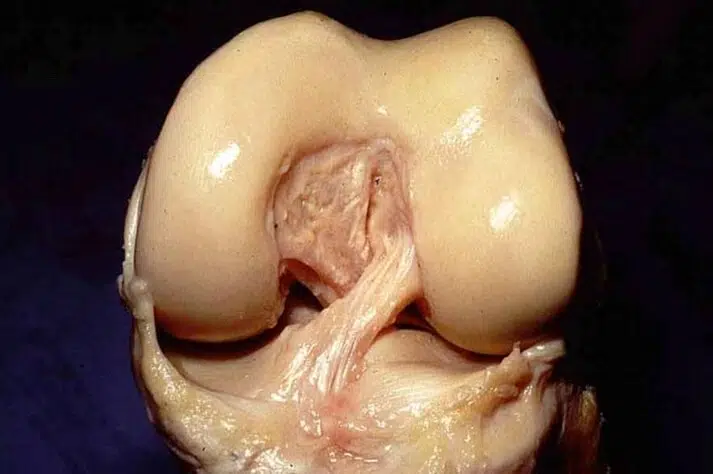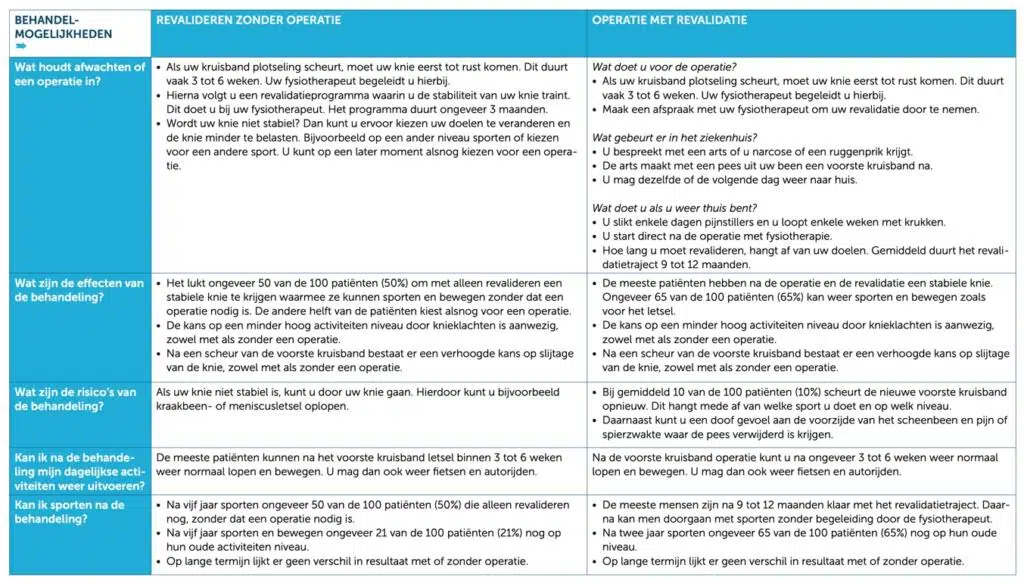Torn anterior cruciate ligament operated quickly
A torn anterior cruciate ligament can cause instability and restriction in the knee. Surgery can help repair the cruciate ligament and prevent further damage. But how soon should a torn anterior cruciate ligament require surgery, and what are the benefits of rapid intervention? In this blog, we take a closer look at this question and give you tips for making the right decision.
Tearing your anterior cruciate ligament isn't nothing. It is also known as the heart attack of the knee. A torn anterior cruciate ligament obviously affects the functioning of the knee. A common complaint is instability. This usually makes playing sports and performing physical work temporarily impossible.
1 in 2000 people tear their anterior cruciate ligament each year. A broken bicycle you get fixed. For a phone that doesn't work you buy a new one. What do you do with a torn cruciate ligament?
The trend over the past 10 years shows an increase in the number of anterior cruciate ligament reconstructions. Yet studies show that 50 percent of people can recover fairly to well without surgery. So what is wise, to operate quickly on a torn anterior cruciate ligament or is postponement also an option? In this blog, we take a closer look at this question.

Unstable knee
Let's start at the beginning: what is an unstable knee? With a little imagination, you can compare the stability of the knee to a tall tower supported by an elaborate supporting structure. The tower consists of support beams and connectors that, like bones and ligaments (such as the anterior cruciate ligament), provide passive stability. In a situation where one of these structures breaks down, a precarious balance is created and the tower might collapse. How great this probability is no one knows. The supporting structure can still keep the tower upright. If it is well organized, the tower will remain standing. With the knee this is the muscle system and because it can be controlled and trained we call it the active stability.
So a stable knee consists of a passive and active stability. This is also called a functionally stable knee. If you tear the anterior cruciate ligament, the passive stability of the knee is reduced. A well-trained muscle system (the active stability) can possibly compensate for this. Because of this compensation strategy, you can still speak of a functionally stable knee. You experience no instability and can move and play sports with confidence. Want to read more about the cruciate ligament click here.
A torn anterior cruciate ligament quick surgery or do you have a choice?
The answer to whether a torn anterior cruciate ligament needs urgent surgery is simple. No, an anterior cruciate ligament does not need urgent surgery. Everyone has a choice and decides for themselves if anterior cruciate ligament surgery is necessary. Doctors and physical therapists can inform you about this and think with you. In a conversation, the important factors are mapped out. Consider short- and long-term goals, work, sports desires, etc. But ultimately, the health care provider is not in your life and therefore cannot determine for you what is best. As variable as life is, so are goals. Therefore, you must weigh for yourself which treatment best suits your personal situation.
In some cases, you almost cannot escape surgery. These include:
- Multi ligament injury (multiple ligaments are torn).
- Additional injuries to specific structures, such as:
- Meniscus tear that can be stitched.
- Posterolateral angle injury (the posterior/outer side of the knee).
- A locked knee (due to a flipped meniscus, the knee cannot fully extend and movement sometimes gets stuck).
- A cruciate ligament rupture that tears almost against the bone can sometimes be sutured (in development) with new surgical techniques.

For more information, see www.consultkaart.nl.
The best result
Back to the main question. Is it wise now to operate quickly or delay anterior cruciate ligament reconstruction?
Recently released research by Reijman et al (2021)* compared these two treatment options in a group of people who tore only their anterior cruciate ligament. Of the participants, one half underwent anterior cruciate ligament reconstruction within two months; the other half did not undergo immediate surgery. Both groups underwent rehabilitation under the supervision of a physical therapist.
Key results after two years:
- 50 percent of those in the group without surgery still had surgery at a later stage. The reason for surgery was often persistent instability.
- Both groups achieved good results with their rehabilitation. The knee regained good load capacity and sports could be resumed fully or not.
- Operating quickly has a minimally better outcome than delaying surgery.
- In both groups, less than half return to their former level of sport.
- Operating quickly: 43 percent, delaying: 31 percent.
- Both groups are satisfied with their treatment:
- Operating quickly: 93 percent, delaying: 91 percent.
The differences between operating quickly or delaying the surgery are only minor. In addition, delaying surgery has a number of advantages.
- You do not undergo surgery and you do not risk complications.
- Conservative rehabilitation is just as intensive but usually shorter than rehabilitation after surgery.
- No high hospital costs.
- The probability of wear and tear is the same for both groups.
- "Better in, better out." Good preparation usually yields a better result should you do have surgery.
Disadvantages of delaying surgery:
- Should you end up needing surgery, total rehabilitation will take longer.
- Persistent instability increases the risk of meniscus injury.
In practice
In complex injuries where not only the anterior cruciate ligament is torn, rapid surgery is more likely to be recommended. The same usually applies to elite athletes. They want to resume their sport as soon as possible and usually have less or no time to wait for a conservative course. Furthermore, in practice we find that young people who would like to resume pivotal contact sports (such as soccer, field hockey, basketball, martial arts, etc.) end up having surgery. There must then be a passively unstable knee.
For those who do not fall into these groups, it is important to realize that the body is a hero at compensating. Through targeted training, the muscle system can be activated and possibly still ensure sufficient functional stability. However, rehabilitation must meet several requirements. Consider intensity, outdoor and/or field training and other complex coordination and stability forms. Simply put, training must be of the same level as after anterior cruciate ligament reconstruction.
Conclusion
What should you do now after an anterior cruciate ligament rupture? Unfortunately, the answer lies in the middle. Of those with an anterior cruciate ligament rupture, 50 percent survive without surgery. However, it is still unclear what factors predict who will make it without surgery. With this blog, we want to point out that after a torn cruciate ligament, surgery is not necessarily the recommended treatment. Which treatment fits best is an individual consideration to be made in consultation with your orthopedic surgeon.
A torn anterior cruciate ligament quick surgery or postpone surgery do you have any tips for others? Leave your comment below.
Bronnen:
* Reijman M, Eggerding V, van Es E, Arkel E, van den Brand I, van Linge J, Zijl J, Waarsing E, Bierma-Zeinstra S, Meuffels D. Early surgical reconstruction versus rehabilitation with elective delayed reconstruction for patients with anterior cruciate ligament rupture: COMPARE randomised controlled trial. BMJ 2021; 372 doi: https://doi.org/10.1136/bmj.n375 (Published 09 March 2021).




